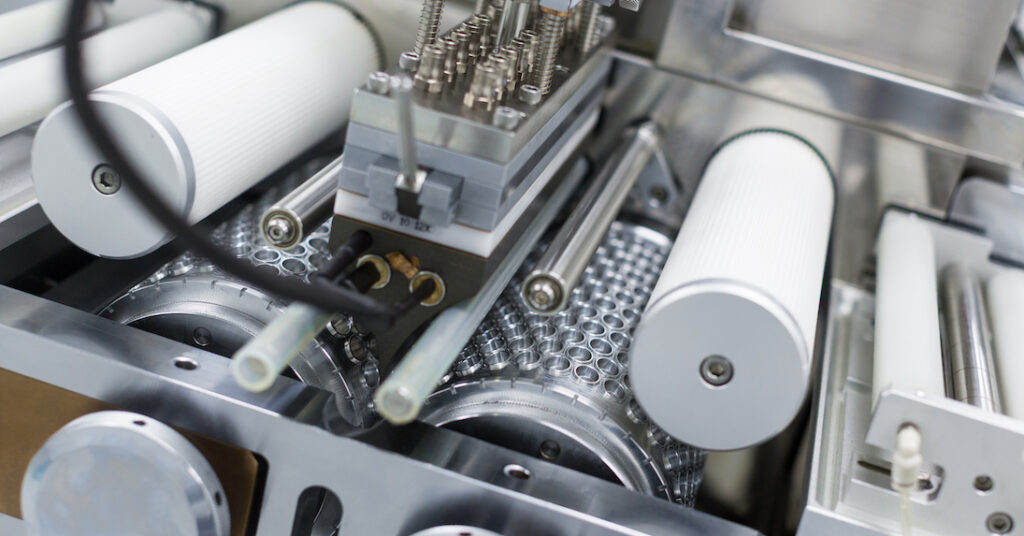Ensuring uninterrupted packaging operations through AI (Part 1)

Did you know? The packaging equipment market is expected to grow to $52.74 billion in 2027 at a CAGR of 5.7%.1
According to experts, the growing need for flexible and integrated packaging machinery is driving the growth of the packaging equipment market. As the demand for efficiency, scalability, and sustainability keeps growing, so does the complexity of the equipment.
Today’s packaging equipment, be it accumulating and collating machines, bottle caps equipment, or sealing machines, is rapidly evolving from standalone machines into intelligent, connected systems. While delivering many productivity benefits, this evolution also brings a new dimension of complexity and means that traditional maintenance and troubleshooting methods such as manual inspection and reactive repairs, are no longer sufficient.
The new-age challenges facing packaging equipment manufacturers
In many ways, packaging equipment is transitioning from mechanical devices to electronic ones and this shift requires new skills and ways of working that present unique opportunities but also challenges. Managing these challenges is key to success and failure to do so will significantly dent efficiency, productivity, and profitability.
Complex diagnostics and triage:
Gone are the days when a simple visual inspection would suffice. Today, diagnosing issues requires a deep understanding of both the machinery and the underlying technology. Traditional methods, which were more reactive, often fall short, leading to prolonged downtimes, inefficiencies in the production line, and increased operational costs.
Loss of institutional knowledge:
The industry’s evolution brings with it the challenge of retaining and transferring accumulated knowledge and expertise. As seasoned professionals retire or move on, there’s a risk of losing invaluable insights and experiences. This knowledge gap can lead to inefficiencies, with newer staff having to ‘relearn’ solutions to challenges that were previously addressed.
Operational blind spots:
In the vast operational landscape of packaging equipment manufacturing, it’s easy to miss critical details. Without a comprehensive, bird’s-eye view of operations, from service management to product management, businesses risk overlooking areas that need attention, potentially leading to resource wastage or missed opportunities.
Reactive maintenance:
The traditional ‘wait-and-fix’ approach is becoming increasingly untenable. Reactive maintenance can lead to unexpected downtimes, increased costs, and disruptions. Moreover, it can result in more extensive damage to equipment, given that issues aren’t addressed at their nascent stages.
Multiple service visits:
The advanced nature of modern packaging equipment often means that a single service visit isn’t enough to fully resolve an issue. Each additional visit escalates operational costs and results in extended downtimes, affecting overall productivity and potentially delaying delivery timelines, which can erode customer trust.
Disconnected equipment systems:
In an interconnected era, isolated equipment systems can be a significant hindrance. The lack of integration can lead to communication breakdowns, data silos, and inefficiencies, making it challenging to have a unified operational strategy.
Unplanned equipment downtime:
Unexpected equipment failures or the sudden realization that a critical part is unavailable can lead to unplanned downtimes. Such disruptions can significantly affect production schedules, leading to delivery delays and potential contractual penalties.
Lack of data-driven insights:
In today’s world, where data drives decisions, operating without concrete data can be a strategic misstep. Without actionable insights derived from data analytics, businesses may find themselves making decisions based on intuition rather than concrete evidence, leading to potential missteps.
Inconsistent performance metrics:
Without a standardized set of performance metrics, assessing the efficiency and effectiveness of operations becomes a challenge. Inconsistent or misaligned metrics can lead to skewed results, making it difficult to identify areas of improvement or to benchmark against industry standards.
Facing these challenges head-on requires a blend of innovative thinking, strategic planning, and the adoption of modern solutions. In the next blog, we’ll delve deeper into potential strategies and solutions that can help packaging equipment manufacturers rise above these challenges and steer their businesses toward success.
Adoption of AI in the packaging equipment industry
Did you know? The use of AI in the packaging market is expected to grow to $6,015.6 million by 2033.2
Over the recent years, AI has gained prominence in the manufacturing sector, and its potential for enhancing the operations of packaging equipment manufacturers is becoming increasingly evident. From utilizing data analytics to gain insights into operational efficiency to leveraging predictive capabilities for issue anticipation and streamlined maintenance, AI offers substantial opportunities for amplifying overall performance in this industry.
AI’s influence has revolutionized operations and optimized equipment performance. Furthermore, the industry’s focus on eco-friendly materials, sustainable consumer goods, and the circular economy has accelerated the adoption of AI, allowing manufacturers to meet changing market demands with innovative and data-driven packaging solutions.
Bruviti: AI is here to help!
Bruviti’s specialized EQAI – Equipment AI helps packaging equipment manufacturers harness the power of AI in their operations.
Bruviti helps packaging equipment manufacturers to minimize downtime and improve operational efficiency. Using AI-driven insights and knowledge, Bruviti empowers field technicians with the necessary tools and resources to swiftly identify and address equipment issues. By ensuring increased visibility into potential problems and offering actionable recommendations, Bruviti significantly boosts first-time fix rate.
Conclusion
The packaging equipment manufacturing industry stands at a crossroads. On one side lies the promise of technological advancements, increased efficiency, and unparalleled growth. On the other, the challenges of modern machinery, a changing workforce, and increasing customer demands. How the industry navigates this landscape will shape its future for decades to come.
In the next installment of this blog series, we’ll explore the AI solutions and strategies that forward-thinking packaging equipment manufacturers are adopting to address these challenges and how Bruviti can be your partner in doing so.
